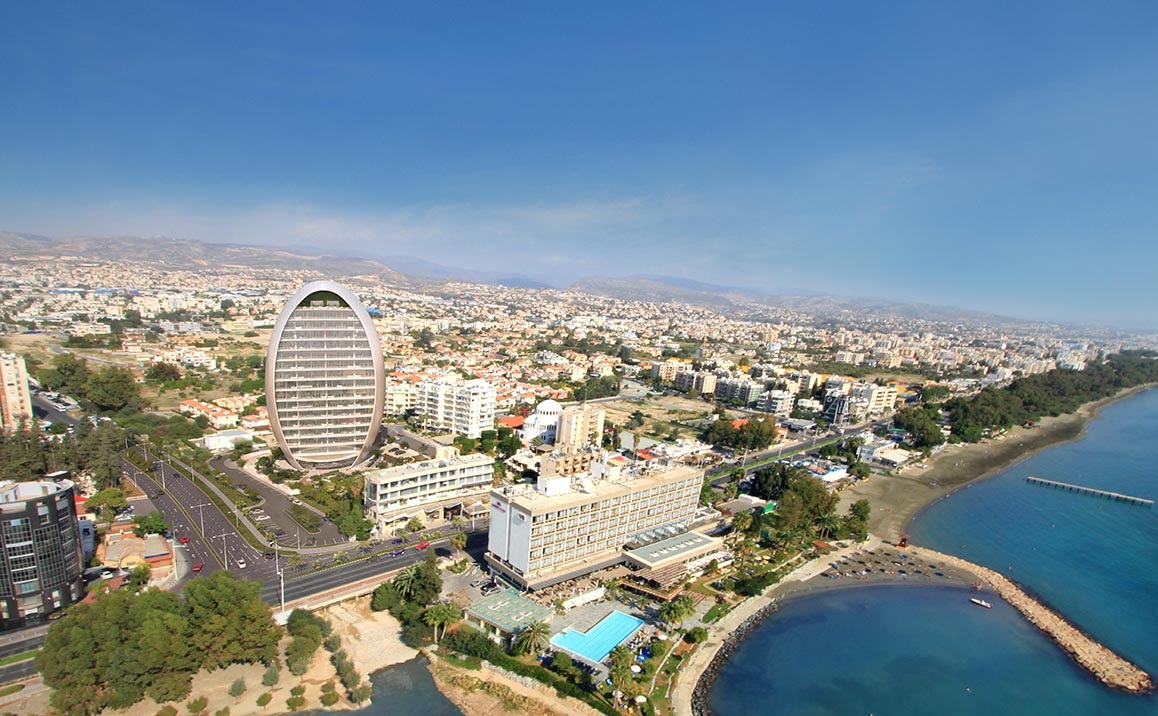
1. Introduction
2016 constituted a generally positive year for the Cyprus property market. After a six-year downward trend, property and rent prices either stabilized or increased, while sales also rose by over 40% across Cyprus. While non-performing loans are still a major issue for banks and real-estate developers, hampering the former from issuing new credit, efforts of restructuring and the application of Foreclosure and Insolvency laws are expected to better the situation within the next year. At the same time, the massive boost in tourist numbers, the improved local and international economic conditions, and the increased demand in property from both locals and foreigners have all contributed to the revival of the property market in Cyprus in 2016. All the above factors seem to indicate that prospects for the future are largely favorable.
2. Signs of Recovery for the Cyprus Economy
2.1. Macroeconomic indicators
In 2016, the Cypriot economy seems to be well on its way for recovery after overcoming the banking system collapse it experienced in 2013. After being given a lifeline in the form of economic bailout by the International Monetary Fund (IMF), the European Central Bank and the European Commission, the Cyprus government implemented austerity measures and reforms to its system and actually managed to successfully exit the program on March 7, 2016 – two months earlier than was expected. The stabilization of the banking system combined with the improvement of other socioeconomic factors has proven that Cyprus is more than capable of returning to a trajectory of growth and fully regain the trust of investors and international markets. In fact, exceeding the IMF’s forecast of a 1.4% growth, GDP increased by 2.8% in Q1-Q3 2016, outperforming the Eurozone’s 1.7% growth. It is expected to continue its positive trajectory by growing at 2.2% and 2.3% in 2017 and 2018 respectively, again outperforming the Eurozone’s expected growth (1.7% and 1.5% in the same years).
Graph 1: GDP Growth
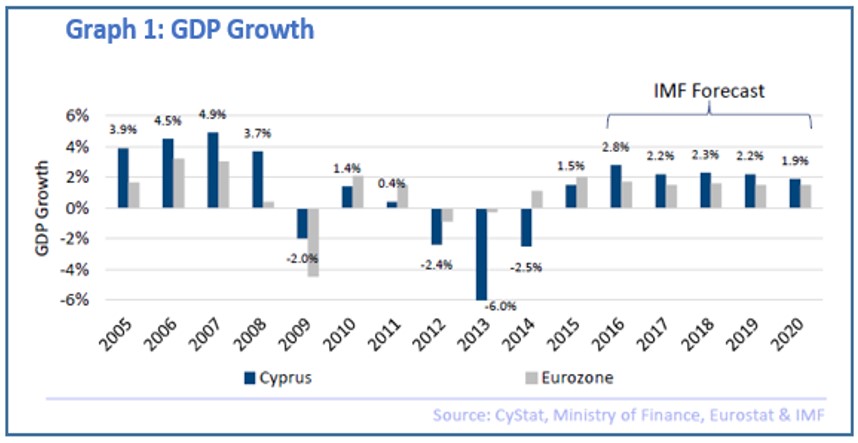
Unemployment rates went down to 13% in 2016, an improvement in 2015’s 14.9%. Though the numbers remain higher than the European average, they are expected to continue dropping within the next few years. In fact, the latest Eurostat numbers show that the unemployment rate has already further decreased to 12.5% in March 2017, an improvement to 12.8% in February of the same year. Improved unemployment numbers can be attributed to economic growth along with certain employment schemes sponsored by the government, though it should not be ignored that the total labor force is decreasing. That could either mean that more people are leaving Cyprus or that a portion of the population has stopped looking for work altogether. However, the boom observed in the tourism sector could form the basis for the creation of more jobs to cover the specific needs of the industry.
Graph 2: Unemployment
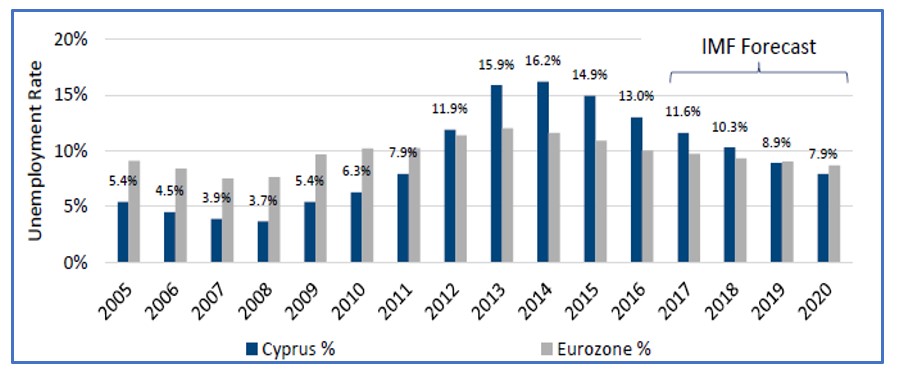
Generally, the government’s determination to implement immediate reform at any political cost has contributed to the upgrade of both the country’s credit rating and its banking institutions by international credit rating agencies. In fact, 2016 was the first time in seven years that the General Government showed an annual surplus of €64,4 mn that corresponds to 0.4% of GDP, while total expenditure decreased by 2.4%. This was noted by the European Commission, the European Central Bank and the International Monetary Fund (IMF) as recently as the beginning of April 2017, since they complimented the Cypriot authorities on their solid performance and encouraged them to build upon their hard-earned achievements.
2.2. Financial System
While the macroeconomic indicators seem to be mostly positive in 2016, the banking system continues to be the sick man of the Cyprus economy. What is making the banking institutions’ attempt of asset reorganization challenging is the massive number of non-performing loans. However, more intensive restructuring efforts combined with the new legislative framework for insolvency and property foreclosures have significantly contributed to the reduction in the level of NPLs. In October 2016, the amount of non-performing loans dropped by €37.6m to €24.1bn, the lowest since the introduction of the Central Bank of Cyprus’ current methodology in December 2014.
The unexpected bail-in of bank deposits (haircut) was also something that had shaken citizen trust, leading to a disconcerting deposit outflow during the years 2013-2014 (the level of deposits was reduced by 35%). However, during 2015 the number of deposits of Cyprus tax residents showed an increase for the first time in four years, while 2016 was an even better year, with deposits of domestic residents rising by €3 billion. Similarly, the deposits of other EU country-residents rose from €2.7 to €3.3 billion. In the case of deposits from residents of other non-EU countries (the lion’s share of which is from Russian depositors), the deposits may have decreased by approximately a billion euro, but the total amount of deposits for 2016 reached the amount of €49 billion, which marks the highest number since July 2013. This indicates that considering the positive developments in Cyprus’ economy, its return to positive growth rates and its early exit from the economic aid program, financial institutions have at least partly managed to regain the trust of depositors.
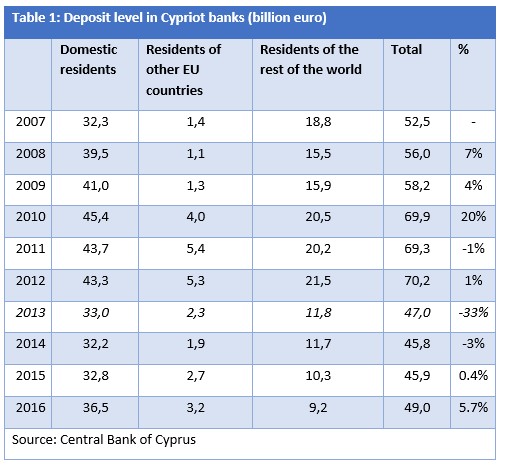
The course of the banking system affects the property market in three ways:
- It influences borrowing costs (housing loans).
- Divestiture law and Insolvency have a direct impact on property movement.
- The property becomes an alternative form of investment.
2.2.1. Borrowing cost
Right after the haircut, the largest Cypriot banks increased borrowing from the ELA (Emergency Liquidity Assistance) and went ahead with a successful recapitalization. In the autumn of 2014, the banking institutions and the cooperative bank successfully underwent Stress Tests from the European Banking Authority and the European Central Bank. Moreover, the Bank of Cyprus, which still possesses the lion’s share in the banking market, managed to first successfully reduce its ELA funding from €11.4 billion in 2012 to €5.5 billion in 2015, and then fully repaid it almost a year ahead of schedule at the beginning of 2017. After doing so in the three years after its near-collapse, it is currently free to offer a dividend again.
In cooperation with commercial banks, the European Investment Bank has also contributed to the general attempt to finance the country’s economy by providing small and medium-sized companies with low-interest loans.
Another important factor that significantly affects the granting of mortgage loans is the reduced strictness concerning funding criteria. From 2010 until the first semester of 2013 there was a tightening of lending criteria when it came to the granting of mortgage loans. In 2015 these criteria were limited, allowing banks to offer more flexible credit provision proposals to borrowers even if financial institutions have restricted the number of housing loans they provide.
At the Eurozone level, important decisions that are favorable for the reduction of lending costs have been taken. In particular, the European Central Bank (ECB) has kept the base interest rate at 0% even if the euro area showed an increase in GDP growth rates by 1.7% in 2016. At the beginning of 2015, the Governing Council of the ECB decided to initiate the Public Sector Purchase Program in the secondary markets. This decision contributes to the strengthening of the economy while at the same time it helps stabilize the banking system.
All these factors on a national and European level have contributed to the significant reduction of loan interest rates, as can be seen in the following Graph and Table. Specifically, based on the most recently published statistical data from the Central Bank of Cyprus, housing loan interest in early 2017 was at 2.9%, a percentage significantly lower than any previous year.
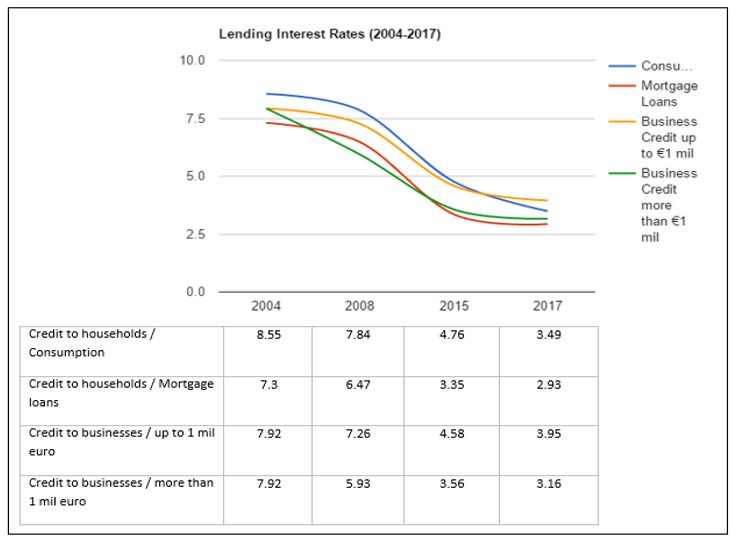
2.2.2. Divestiture Law and Insolvency
Despite the significant reduction of interest rates, the high percentage of non-performing loans is one of the main reasons why banks are particularly cautious with credit provision processes. Because of the inability of a large number of borrowers to meet their financial obligations, the Cyprus Parliament passed the divestiture bill that grants banks the power to confiscate and auction off the property. Yet the process is far from easy, as experience from the USA and other Southern European countries has shown, which was why only a few months after the bill was voted through, it was temporarily suspended and then re-enacted in 2015. More than a year later, on June 2016, the Bank of Cyprus tested the foreclosure law with five auctions in Paphos, with mixed results. The chairman of the Cyprus Land Development Corporation has stated that the banks will mainly focus on commercial real estate, holiday homes or land plots, with a very limited number of primary homes foreclosed, as they are aware of the implications of auctioning a property with a tenant that would later have to be evicted. What is certain is while the European Commission pushes for a strengthening of the foreclosure law in order to boost growth and minimize fiscal risks, it is definitely not easy to implement. While the law is a particularly important tool in the consolidation effort of banking assets, there is a danger of crashing the market since, in the case of a massive wave of foreclosures, there might be an equally massive price collapse. If they do not want to crash the market, banks should create property investment packages that will subsequently be securitized and exclusively promoted to investment funds abroad.
2.2.3. An Alternative Form of Investment
The haircut on deposits has been a determining factor in shaping Cypriots’ investment behavior. The massive problems of the banking system made Cypriots particularly suspicious about the banks’ ability to protect their deposits. Because of its material and tangible nature, for many investors, the property market constitutes a safe refuge for their savings. This is one of the main reasons why in the first semester of 2014, domestic demand for property increased by 26.1% compared to the first semester of 2013, despite the economy’s collapse. The significant increase in sales in the domestic market continued in 2015, while 2016 showed an impressive rise of 43% in real estate sales for domestic buyers and a 32% increase for foreigners, as the data released by the Department of Lands and Surveys showed.
An important role in the upgrade of property as an investment solution is also played by the successful upgrade of the terms for granting residence permits and citizenship status to people who choose to invest in real estate, as will be discussed below in more detail.
2.2.4. Reduction of Bank Credit
Despite the continuous remarkable decrease of loan interest rates, the high indebtedness of households and non-financial corporations (NFCs) still constitutes one of the major vulnerabilities of the financial sector and it seems to have led to the further tightening of credit provision to the domestic private sector. More specifically, the provision of credit to the domestic private sector as a percentage of GDP was 250.2% in 2015Q2, while it further decreased to 238% in 2016Q2. Moreover, the ratio of debt repayments to annual total income also followed a downward trend since 2014, reaching 10.2% in 2016Q2, and this may be one of the reasons banks are more reluctant to provide loans to households and NFCs. Mortgage loans that were a determining factor for the property market growth in the golden era of 2000-2007 also decreased by 1.3% in 2016.
3. International Developments
3.1. Tourism and Permanent Residence
Cyprus is one of the top Mediterranean tourist destinations, and 2016 saw a massive increase in the total number of tourist arrivals with an impressive 3.18 million people on the island. 2017 is, in fact, expected to be a record year for Cyprus, since March 2017 had the highest volume of tourist arrivals ever recorded during the specific month, and the winter season (November 2016-March 2017) saw an increase of 13.6% compared to the same period last year – making it the second-best in tourist arrivals of all time. Bookings from the United Kingdom, the biggest tourist market for Cyprus which had temporarily slumped between 2012 and 2014, are marking an increase of 10% in 2017 compared to 2016.
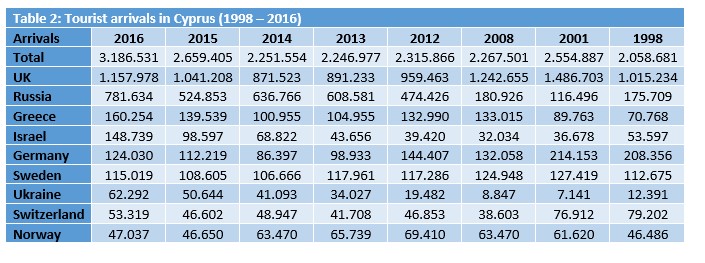
Charmed by the natural beauty of the island, a big number of tourists decide to purchase a holiday home. Up until 2004, this market was monopolized by British pensioners. Paphos was the district that housed the biggest English-speaking community in Cyprus, given that in the last population census of 2011, 12% of the district population were UK nationals. The financial crisis of 2008 and the depreciation of the pound sterling against the euro led to a decline in the purchasing power of the British and the subsequent decrease in property sales in Cyprus. In order to balance out the negative consequences while taking advantage of Cyprus joining the EU in 2004, the government-initiated programs through which it grants permanent residence and citizenship to third-country nationals through investment. Especially after the upgrade of their terms, these programs remain highly successful, with the greatest interest shown by Russian, Ukrainian, Chinese and Arab investors, who are mostly interested in a luxury property close to the sea and on central locations.
3.2. The UK Economy and Brexit
The UK was one of the first western countries to escape the 2008 financial crisis. The country’s GDP continuously had positive growth rates, with 2.9% and 2.2% in 2015 and 2014 respectively. In 2016, however, the British public was called on to vote in a referendum that was meant to decide whether the UK would remain in the European Union, and a majority of 51.9% decided for Brexit. What followed the referendum result was immediate economic repercussions felt global. Despite its revaluation of 30% against the euro in 2015, the sterling pound plummeted to a 31-year low against the dollar and lost 13% of its value against the euro, and many feared that the country would slip into recession. Nevertheless, the UK economy proved to be more resilient than forecasters had predicted and actually grew by 2% in 2016 – a number slower than the previous two years, but better than anticipated after the shock outcome of the referendum. However, economists are still expecting a slowdown within 2017 as higher inflation affects consumers’ ability to spend. In an environment of instability and uncertainty, as the negotiations for an EU exit have yet to begin, this may, on the one hand, mean that the decreased purchasing power of British nationals will affect their ability to spend on the Cypriot property market. On the other hand, since several individuals or businesses will be looking for another EU base in order to maintain their European passport, Cyprus could constitute an attractive investment destination, as the purchase of property offers the possibility of permanent residence status or citizenship.
3.3. The Russian Economy
Russia has been the most important source of Foreign Direct Investments (FDI) in Cyprus since 2008, which was when Cyprus joined the Eurozone. Thousands of Russian businesses have a tax base in Cyprus while in the last ten years a big portion of these companies has also established a physical presence on the island. Wealthy Russian nationals have bought a second home in Cyprus and through a fast-track procedure have been granted permanent residence or citizenship.
These outstandingly good relations, not shaken even during the deposit haircut, are facing two challenges. Firstly, the annexation of Crimea from the Russian Federation on 18th March 2014 led to two-way financial sanctions between Russia and the EU. These sanctions mainly affect the export of Cypriot agricultural products and do not seem to have any major impact on the banking and tourism sectors, since 2016 saw the highest number of Russian tourist arrivals ever recorded on the island. Despite this, even if the Cyprus government has been very vocal about its opposition to the sanctions, labeling them ‘counterproductive’ and assuring their Russian counterparts that they will do everything in their power to shift the conversation among other EU members towards more constructive approaches, the EU continues to be firm on its terms regarding the lifting of sanctions and Russia has prolonged its embargo on Western food imports until the end of 2017.
The second challenge concerns the great reliance of the Russian economy on oil since the country is considered one of the world’s biggest energy exporters. The volatility of the market when it comes to oil prices has a direct effect on the country and its currency. In fact, between July 2014 and January 2016, the euro was revaluated against the rouble by almost 100% after the collapse of oil prices (see the following graph).
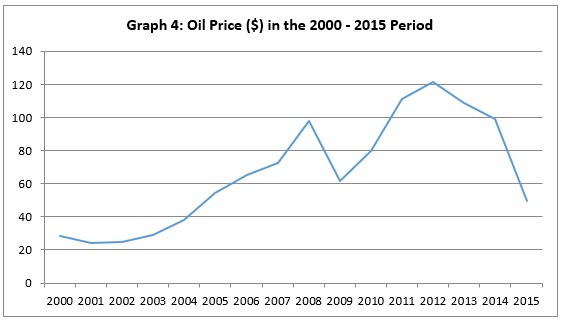
Nonetheless, 2016 was a good year for the Russian economy that returned to growth at the end of the year, after seven consecutive quarters of contraction. The gross domestic product gained 0.3% from the year before, while the rouble was among the world’s top three performers and was appreciated almost 9% against the dollar in 2017. The positive developments in the Russian economy were reflected in the Cypriot property market, with Russian investors showing a massive interest in buying real estate in 2016.
There are also encouraging signs from the tourism sector. The shooting down of Russian Sukhoi Su-24M aircraft from a Turkish Air Force jet on 24th November 2015 had, as a result, the deterioration of Russia-Turkey relations and the signing of a presidential decree which banned chartered flights to Turkey prevented tour firms from selling holiday packages there and halted the existing visa-free regime between the two countries. Russians who visited Turkey in 2014 and 2015 amounted to 4.5 and 3.6 million respectively. There is also an increased danger of a terrorist attack on Turkish ground, as the country has been a victim of several terrorist acts in the last few years.
The heightened danger of a terrorist act is also the reason for a substantial decrease in Russian flights to Egypt. On 31st October 2015, the ISIS terrorist group placed an explosive device on Russian flight 9268, leading to the airplane’s crash in Sinai and the death of 224 people. Russia immediately issued a decree by which it canceled all flights to Egypt.
Consequently, the tourists that were planning on visiting either Turkey or Egypt started looking for safer alternatives and Russian travel agents began redirecting the tourism current towards countries like Greece, Spain, and Cyprus. In fact, Russian tourists that did not exceed 120 thousand in Cyprus back in 2001 reached an impressive 781 thousand by 2016, and as early numbers from 2017 show, this wave of Russians is only expected to increase. Also taking advantage of the presence of a large Russian community in Cyprus (approximately 40,000 permanent residents), the Cypriot market has created effective infrastructure and mechanisms to attract and serve Russian customers, so they are more than prepared to handle the increased traffic.
3.4. The Chinese Factor
One would think that a country located so far away would ordinarily have no interest in a small island like Cyprus. Yet Cyprus and China have successfully been engaged in business relations for some time now, with the Chinese seeing the island not only as an entry point for the wider market of the European Union but as a bridge linking Chinese businesses to Africa, the Middle East, and Russia. After the central bank of China proceeded in a surprise devaluation of the currency in an attempt to boost the country’s exports in 2015, Chinese interest in investment abroad peaked, and since interest rates in the US and EU remain at low levels, this forced Chinese businessmen to explore less traditional options like Cyprus. This was something that the property developers from the Paphos area realized early on since they were the first to visit China in order to attract customers right after the 2013 bailout, making the Chinese market a priority. The Chinese contribution to the local economy is definitely not negligible considering their investment in the Paphos area was one of the main reasons the property market jumped 40% in 2016 compared to 2015 according to the president of the Cyprus Association of Valuers and Property Consultants. Data from the immigration department indicate that applications for a residence permit in Cyprus have increased by thousands within the last few years, while it is calculated that over 4,000 property deals have been signed since 2013.
At the same time, even if the number of Chinese tourists is small compared to arrivals from other nationalities, there are prospects for the development of the sector that the government is actively trying to take advantage of. The Cyprus Tourism Organization is already seeking to establish offices in Beijing and Shanghai, while the Ministry of Foreign affairs is trying to simplify the review process of travel documents and decrease the time it takes for them to be issued. Meanwhile, some travel agents have signed agreements with their Chinese counterparts aiming to increase the tourist current from China, while certain Cypriot airlines are planning to introduce direct flights to the country in their schedule within the next year.
4. Property Price Changes
4.1. Residential Property Price Index Changes
During 2006-2008 the property market in Cyprus turned into a financial bubble environment, whose creation was enabled by the uncontrolled granting of mortgage loans by banking institutions. In financial terms, the current period of the property market could be characterized as a “period of correction” or a “period of rationalization” of supply and demand. After a seven-year drop in prices, 2016 was the first-year property prices and rents either stabilized or increased.
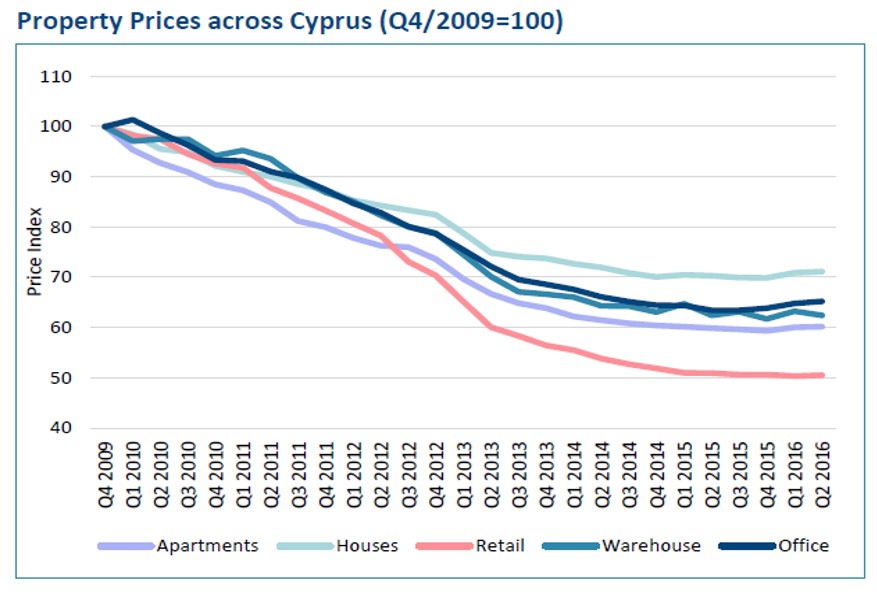
As can be seen in the graph above, the steep drop in prices during 2013-2014 started being contained in 2015 and that continued in 2016Q2, with prices for houses, flats, and offices marking a small increase, while warehouse prices remained stable. Only retail property marked a small drop in prices. As the table below shows, the RPPI recorded a marginal increase of 0.1% on a quarterly basis in 2016Q3, the first increase since 2009. This reflects the trend for price stabilization in the property market.
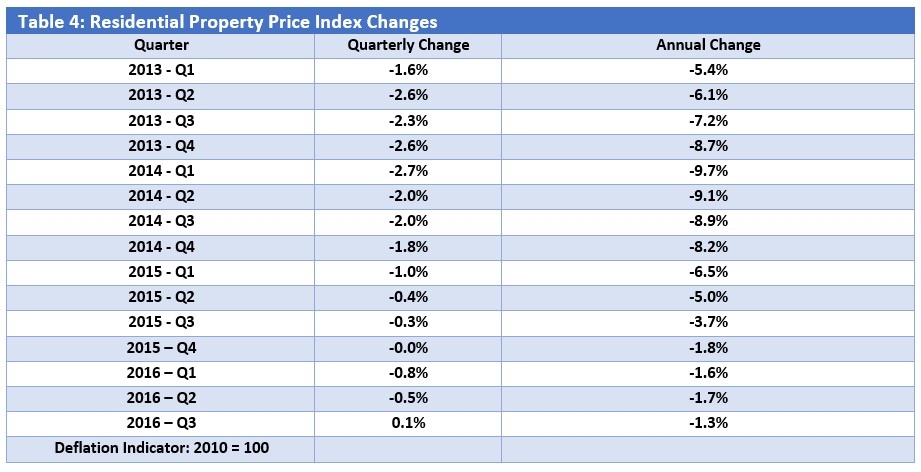
The following table analytically shows how prices have changed in the house and apartment market. It can be observed that in the last four years, apartment prices have undergone a comparatively bigger reduction, making this market particularly attractive for prospective buyers. In fact, the president of the Cyprus Real Estate Agents Association has recently confirmed that Cypriots are mostly interested in apartments located in residential areas as a permanent residence and are only looking into houses in some cases.
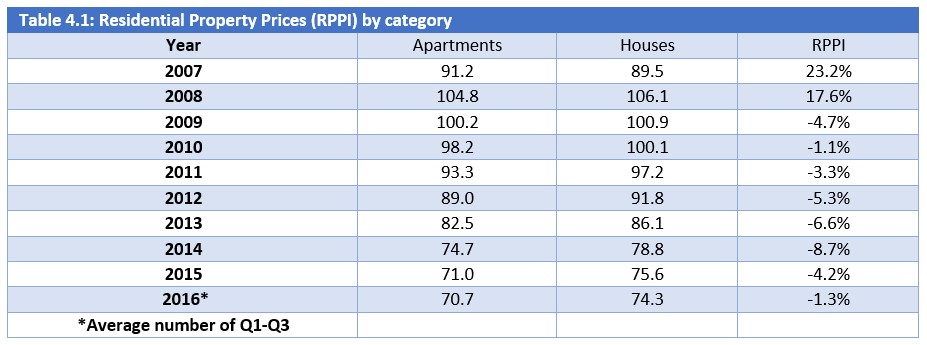
4.2. Average Property Price Changes by District
If we examine property prices on a district level (Table 5), we can see that macroeconomic conditions symmetrically affect property prices in all districts.
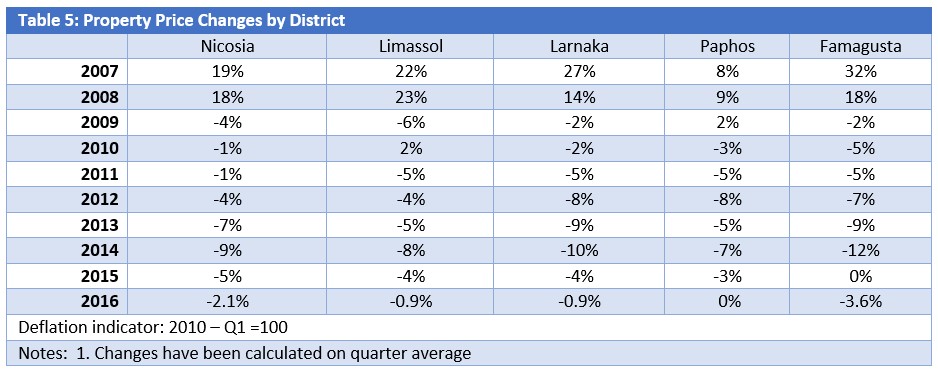
In Graph 6 below, we can see a comparative detailed analysis of residential property prices in different districts during the period of economic recession 2011-2015, as well as the numbers for 2016.
Graph 6: Sales Prices of Residential Units per District, 2011-16 (€, €/Sq M)
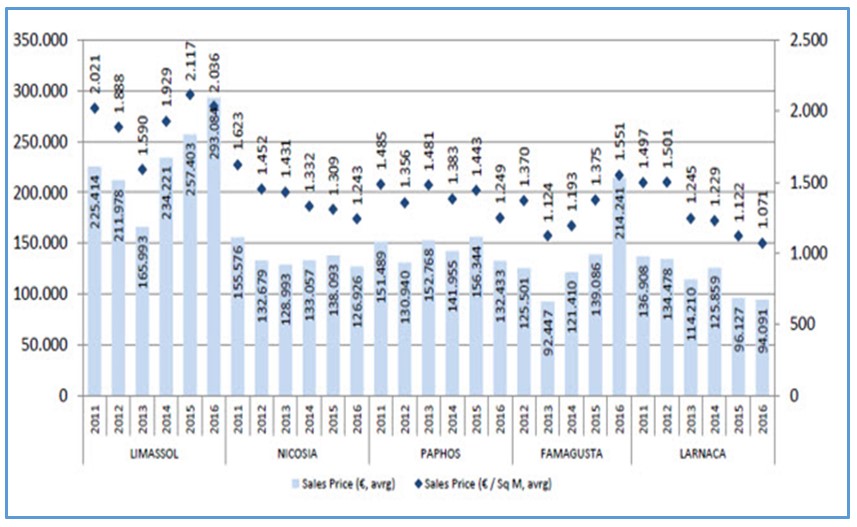
As the graph above shows, 2013 and 2014 were the years with the highest decrease for almost all districts. The only exception was Paphos, which experienced mass sales from English pensioners in 2012 due to the difficult financial situation in the UK. As can be seen in the two graphs below though, Paphos is nonetheless the district whose property market also shows the strongest signs of stabilization in 2016, as it not only is the only district showing a positive quarterly and annual increase, but it also has the highest demand for property.
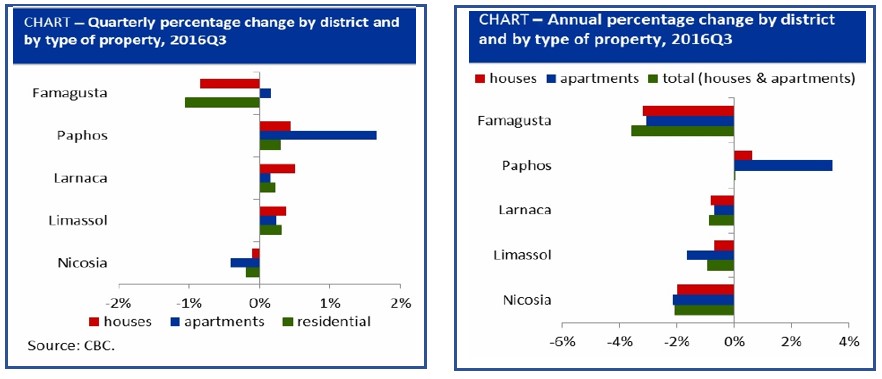
Because of the high demand for holiday homes by Russian nationals, the Limassol district had a comparative smaller reduction up until 2015. Because of the citizenship through investment program, the demand for luxury property in tourist areas kept the steep price drop observed in other districts under control. An important factor for market stabilization in Limassol was the interest in office and other commercial property rentals. The high demand for offices and luxury homes contributed to obtaining funding for big investment plans, like the Oval of the Cybarco Company and the ONE skyscraper by the Pafilia Company. Even if the annual percentage change for the district was negative in 2016, Q3 saw an increase in the prices of both houses and apartments.
2011-2014 was a particularly challenging period for Larnaca and the Free Famagusta district, with the latter going through the most significant annual decrease of all the districts in 2014 when it saw its property prices collapsing by 12%. Famagusta, which is highly dependent on seasonal tourism of a low-income scale from Russia, was particularly affected by the notable devaluation of the rouble. The significant property price reductions contributed to the creation of exceptionally good investment opportunities, resulting in an increase of supply while the prices remained unchanged for 2015. 2016 was only better when it came to apartment prices in Q3, as an increase of 0.2% was recorded; on an annual basis, both apartment and house prices decreased by 3.1% and 3.2% respectively. Larnaca saw a similar, albeit much smaller annual drop, with apartment prices marking a decrease of 0.2% and house prices one of 0.8%. It did, however, record an increase of 0.2% in apartment prices and 0.5% in house prices in 2016Q3.
5. Number of Sale Contracts
As can be seen in the following graph, the significant drop by 8.7% in the Residential Property Price Index in 2014 contributed to a surge of sales in the same year. This was mostly due to the increased property demand by Cypriots.
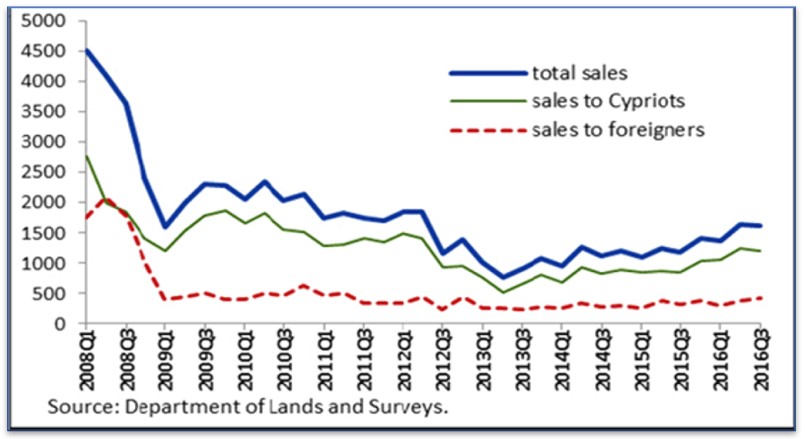
In 2015 the favorable climate for sales continued, recording an increase of 6% for the third quarter. Specifically, purchases by Cypriots increased by 2.7% while purchases by foreigners skyrocketed, increasing by almost 16%. Sales continued to soar in 2016, with the total number of sales contracts recording an annual increase of 38.1% in Q3. For the same quarter, the number of sales contracts with foreign buyers increased by 28.8%, while property transactions with Cypriot buyers registered an annual increase of 41.7%.
Early statistics recorded in 2017 show that an even bigger number of sales is predicted within the year. In fact, figures released on March 2017 by the Department of Lands and Surveys show that sale contracts were on a strong rise in Paphos with an increase of 53% compared to the same month in 2016. The number of property transactions also rose 18% in Limassol and 21% in the Famagusta area. Nicosia and Larnaca registered a small drop of 4% and 7% respectively compared to March 2016. In the first three months of 2017, the total number of property transactions rose 10% to 1,505 compared to the respective quarter of 2016. Property transactions increased by 4% in Nicosia, 16% in Limassol, 3% in Larnaca and 20% in Paphos. The only district marking a drop was Famagusta, with 11% fewer transactions than 2016.
5.1. Building Permits
While building permits dramatically dropped in 2013 and 2014 because of the financial crisis and a large number of non-performing loans in the real estate sector, they seem to be tentatively back on the rise.
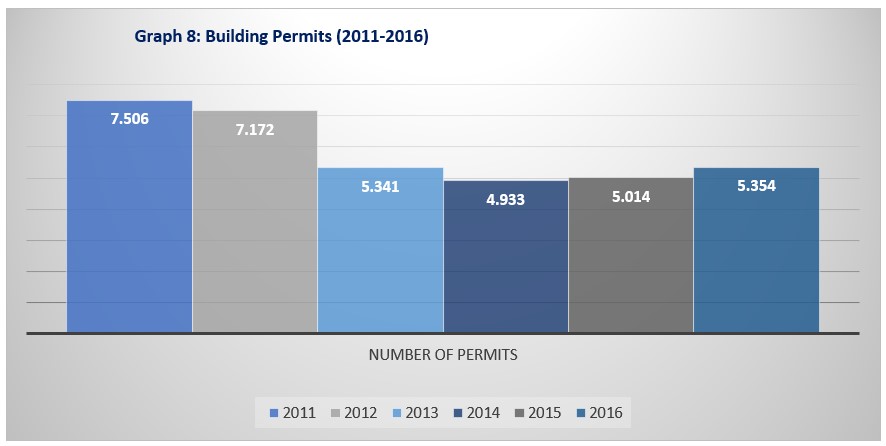
By the end of 2016, 5,354 building permits had been issued compared to the 5,014 issued in 2015. Found in Table 8 below are the number of permits issued per district since 2011.

As can be seen, all the districts marked an increase in building permits from 2015 to 2016 except for Paphos. Though the numbers remain at a much lower level than that of 2011, the small rise is nevertheless a positive indication for the gradual recovery of the real estate market. The first indications from 2017 are already encouraging, with 909 building permits issued in January-February 2017 compared to the 794 of the respective months in 2016. Similarly, there was an increase in almost all districts. Permits in Nicosia rose to 341 from 292, Limassol went from 222 to 245, Paphos issued 153 permits to the 110 of 2016, while Famagusta went from 49 to 53. The only district that marked a small decrease in building permits was Larnaca, which issued a total of 117 in January and February 2017 compared to the 121 it had issued the previous year.
6. Rentals
6.1. Average rent
The rental sector is one of the most important parts of the property market since the financial crisis has contributed to a revitalized interest in it. The massive tourist flow expected to be directed to Cyprus in 2016 turns the property that will be used for tourist rental into a significant investment opportunity.
The following tables present the average rent by district and the initial yield for a three-bedroom semi-detached house and a two-bedroom apartment at the end of 2015. As can be seen on the table, the highest rent for houses is recorded in the Limassol district and the lowest in the Famagusta district, while the highest rent for apartments is found in the Nicosia district (even if it is only marginally higher than Limassol) and the lowest is once again in the Famagusta district.


Table 9 presents the number of residences by district and by average monthly rent. It appears that the vast majority of residences are rented for between 200 and 400 euros per month.
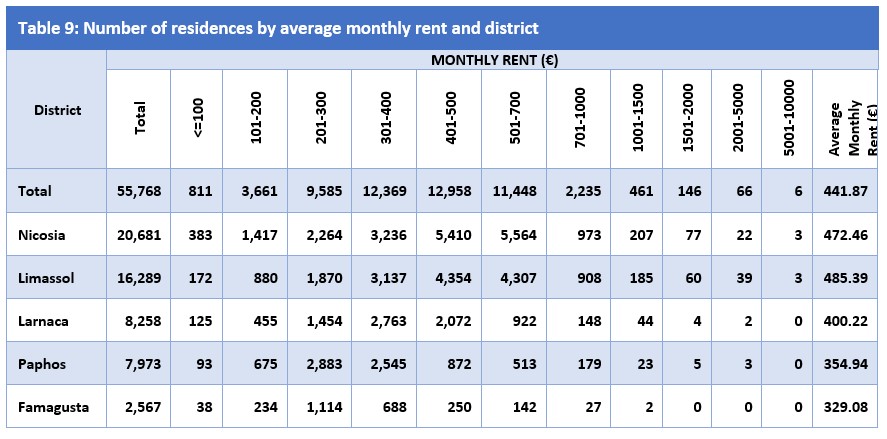
The table below shows the average rental cost depending on the average rent and room number.
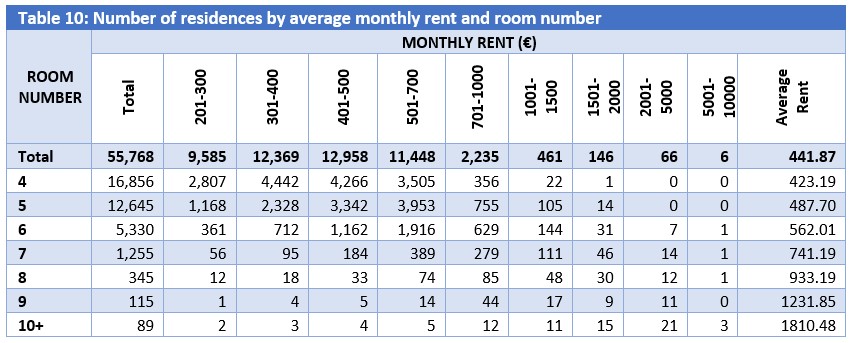
It needs to be noted here that rental prices seem to continuously rise in the past year, mainly because of increased demand by both Cypriots and foreigners. Q1 of 2016 showed an increase in rental values by 3.6% for apartments and 1.8% for houses, while Q2 marked a further rise of 0.4% and 0.5% respectively. In Q3 of 2016, rental values increased a further 0.7 for apartments and 3.3% for houses.
6.2. Rental market prospects
The rental market in Cyprus is expected to generate an even greater interest in 2017 than in 2016 for the following reasons:
- The unstable situation in the nearby Arabic countries and the fear of a terrorist attack is expected to contribute to the increase of tourist flow towards Cyprus and other European countries on the Mediterranean Sea. Cyprus is, in fact, the number one safest small country in the world while it ranks 5th worldwide according to a 2015 study of an American insurance company. This makes it an attractive destination for holidays compared to other similar destinations.
- Even if the UK economy is still unstable as it enters unknown territory with Brexit negotiations, the number of tourists visiting Cyprus in 2016 and the beginning of 2017 are more than encouraging; arrivals are only expected to increase.
- The high unemployment percentage and the reduction of Cypriots’ purchasing power mean that there is a transition of interest from house purchases to apartment rentals.
7. Cost of living and other relevant indicators
Low property prices, lower demand and the inability of many construction companies to pay off their loans continue to significantly affect the construction sector. Local sales of cement recorded an annual increase of 6.8% during the third quarter of 2015, compared with an annual decrease of 13.7% in the same quarter of the previous year. The price index of construction materials reduced on an annual basis by 3.2% in the third quarter of 2015, and it continued to decrease in 2016, going from 102.27 to 100.50. The decrease is mainly due to the major drop in oil prices since oil is a basic production factor in the construction process (Graph 4).
A significant decrease was also observed in the cost of living in Cyprus during 2016. As can be seen in the diagram below, the cost of living, water, electricity, and gas (compared to the cost of the same months in 2015) has become lower than the Consumer Price Index.
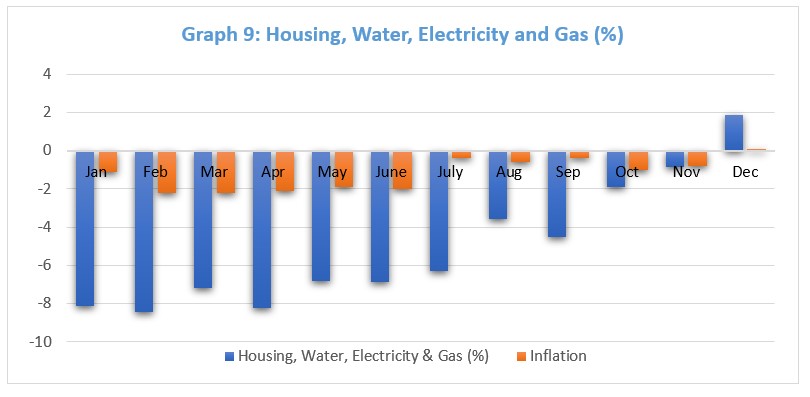
8. Improved framework for the issuance of title deeds
Until today, the regular functioning of the property market was impeded by the underdeveloped title deeds issuance system. Unfortunately, buyers were often trapped in time-consuming bureaucratic procedures that stopped them from issuing their title deeds, either because the property was mortgaged by the seller or due to the fact that the seller owed tax to the state. To face this problem, the government forwarded a relevant bill for structural changes, which came into effect on September 2015. The bill was crafted to make the process of issuing building permits more efficient and protect the rights of ‘trapped’ buyers who could not proceed with the transfer of their property due to outstanding taxes or mortgages of the developer. The Amended Transfer & Mortgage of Properties Law No.139(I)/2015 gives ‘trapped’ purchasers of property the chance to apply for its transfer in their name. The main conditions are that the buyer has fully settled the purchase price, as well as any outstanding tax obligations like immovable property tax, town/community and sewage rates and that the subject property holds a separate Title Deed. This amendment is expected to restore confidence in the Cypriot property market, making the property more attractive.

